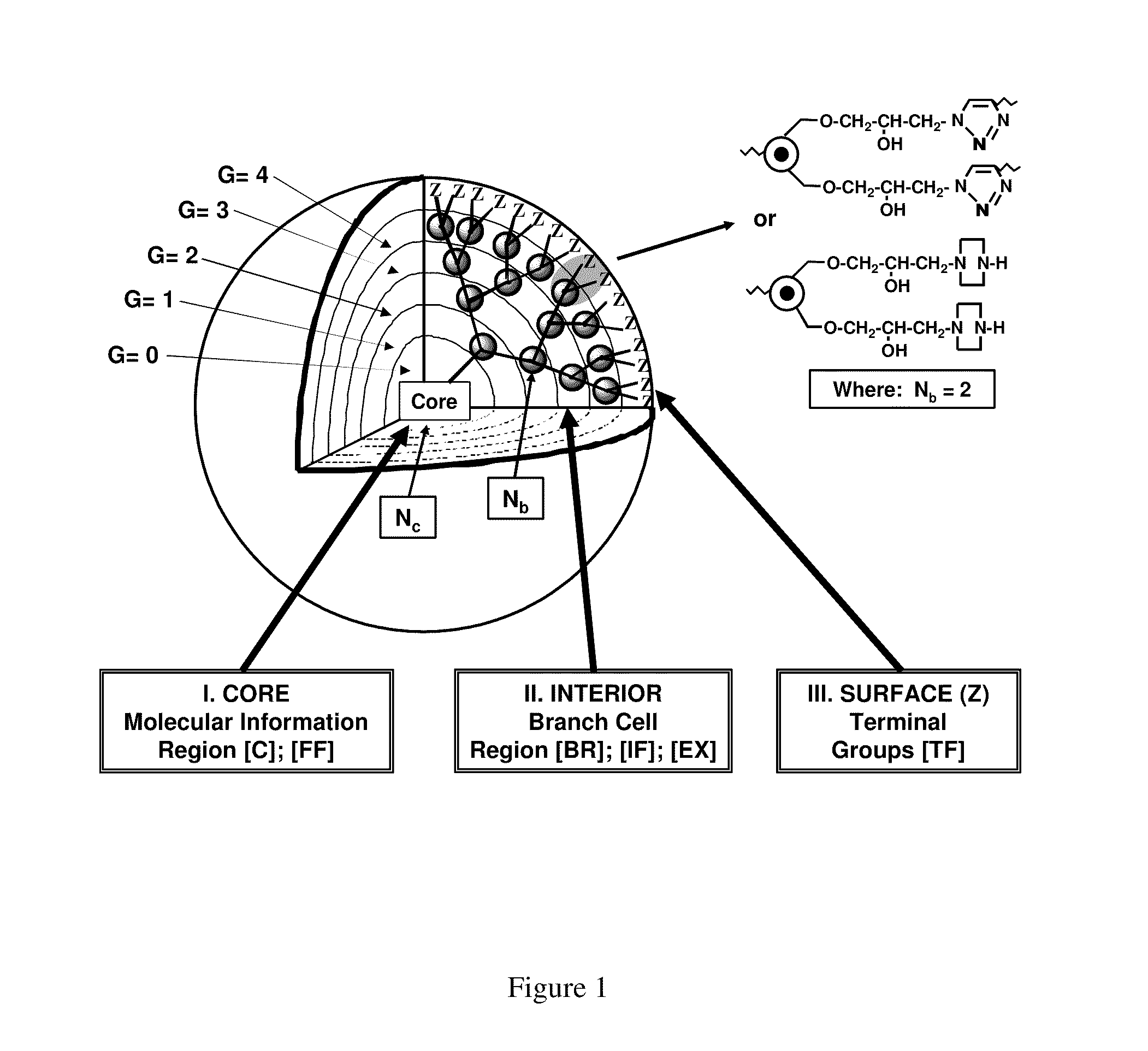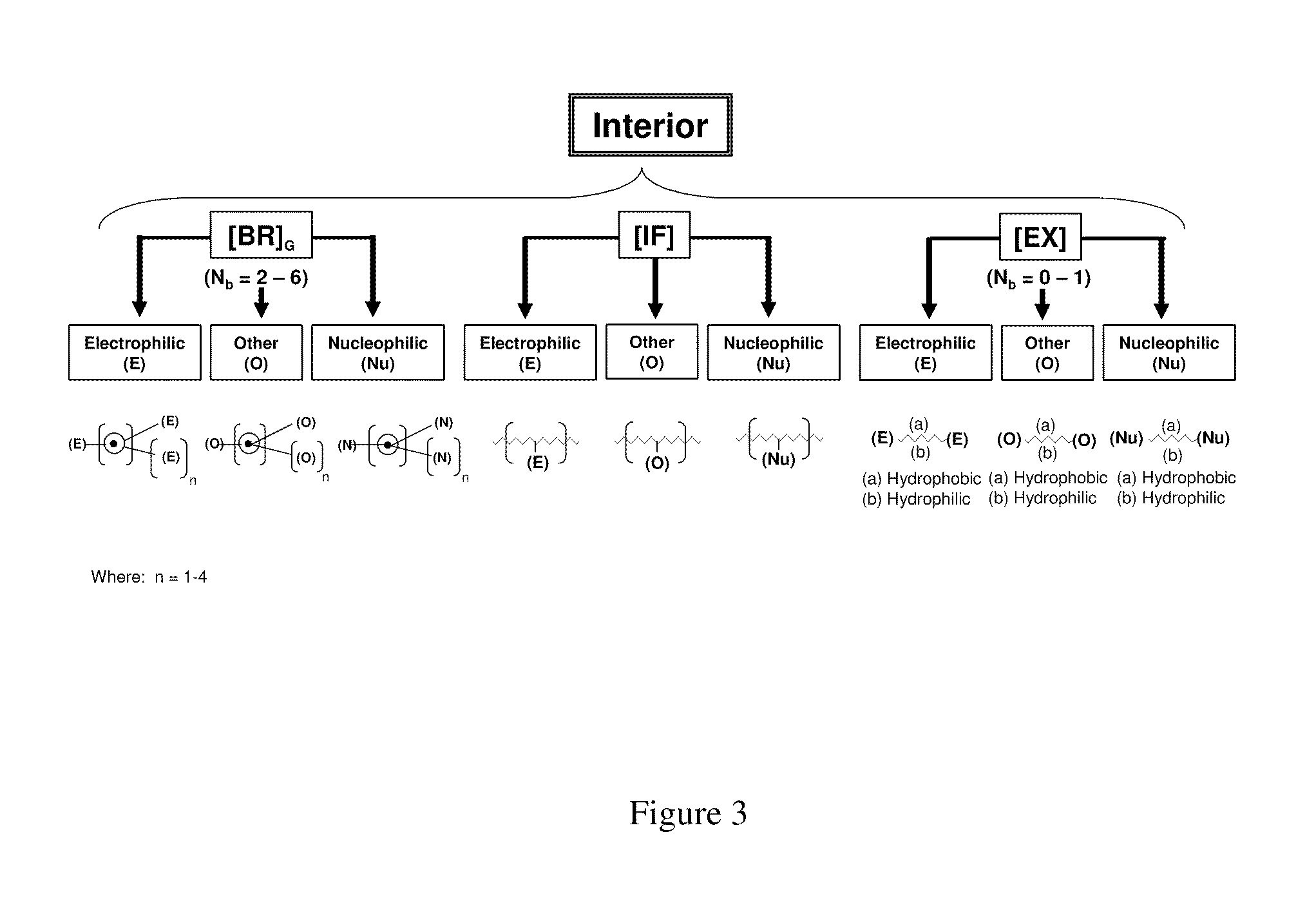Dendritic polymers with enhanced amplification and interior functionality
a technology of dendrite polymer and amplification, applied in the field of dendrite polymer, can solve the problems of inability to amplification, and inability to synthesis dendrites, so as to reduce the relative size of alkyl groups, minimize the steric effect, and reduce the reactivity
- Summary
- Abstract
- Description
- Claims
- Application Information
AI Technical Summary
Benefits of technology
Problems solved by technology
Method used
Image
Examples
example a
Preparation of Pentaerythritol Tetraglycidyl Ether from Pentaerythritol and Epichlorohydrin (EPI)
[0430][(C)=PETGE; (TF)=Epoxy]
[0431]To a 100-mL round bottom flask containing a large stir bar was added pentaerythritol (4.1 g, 30.1 mmols, 120 mmols OH) (Aldrich) and 30 mL of a mixture of DMSO (15.85 g) and KOH (13.47 g, 240.0 mmol, 2 equiv. per OH). To this rapidly stirred mixture in a water bath at RT was added dropwise (about 1 drop per 10-15 sec) epichlorohydrin (34.0 g, 367.0 mmols, 3 equiv. per OH) (Aldrich) over 60 to 90 mins. The temperature was monitored every 10 mins. to maintain the temperature below 35° C. After another hour the exotherm had subsided and the mixture was heated to 35° C. for 5-6 hours. The reaction was monitored by TLC (7:3 toluene-acetone). Spots were visualized from KMnO4 stain. Aliquots were added to the ether-brine mixture to remove DMSO and the ether layer dried with Na2SO4. The TLC of the reaction mixture showed 5 spots after the addition was complete,...
example b
Synthesis of Pentaerythritol Tetraglycidyl Ether from Pentaerythritol and Epichlorohydrin (EPI)
[0435][(C)=PETGE; (TF)=Epoxy]
[0436]This process was performed according to Mitsuo et al., Synthesis, 487 (1993). Pentaerythritol I (13.6 g, 400 mmol) and 100 mL DMSO were taken in a 1-L 3-necked round bottom flask and then KOH (52.7 g, 800 mmol, 2 equiv. per OH) added all at once. The reaction mixture was stirred vigorously with a mechanical stirrer and cooled to 15-20° C. with an ice bath. Epichlorohydrin II (110.4 g or 93.55 mL, 1.2 mol, 3 equiv. per OH) in a pressure-equalizing funnel was added dropwise over a period of 150 min. The temperature was maintained at 15-20° C. during the addition of epichlorohydrin. The color of the reaction mixture turned from colorless to pale yellow. After completing the addition, the reaction mixture was allowed to warm to RT and stirring continued overnight. Progress of the reaction was monitored by TLC. After 3 hours, TLC indicated spots for pentaeryth...
example c
Synthesis of Pentaerythritol Tetraglycidyl Ether from Pentaerythritol Using Allylbromide and m-Chloroperyoxy Benzoic Acid (m-CPBA)
[0440][(C)=PETGE; (TF)=Epoxy]
[0441]Pentaerythritol, I (15.03 g, 110 mmol) (Acros Organics) and 250 mL of THF were mixed in a 1-L round bottom flask. KOH (85.93 g 1.35 mol 3.0 equiv. per OH), and tetrabutyl ammonium bromide (TBAB) (0.460 g, 1.23% mol) (Acros Organics) were added via powder funnel, followed by addition of allyl bromide, H (106.6 g, 1.35 mol, 3.0 equiv. per OH) via a 125-mL addition funnel over 10 mins. The reaction was then immediately placed into an oil bath at 70° C. for 24 hours. The reaction was monitored by TLC (110:1 hexanes:ethyl acetate), showing the product spot at Rf=0.4 and no spots for tri-, di-, or mono-allyl-substituted pentaerythritol. The reaction mixture was vacuum-filtered through a 150-mL coarse glass-fritted Büchner funnel. The organic layer was diluted with diethyl ether (2×250 mL). The organic layer was washed with 5% ...
PUM
| Property | Measurement | Unit |
|---|---|---|
| concentration | aaaaa | aaaaa |
| temperature | aaaaa | aaaaa |
| electrophilic | aaaaa | aaaaa |
Abstract
Description
Claims
Application Information
 Login to View More
Login to View More - R&D
- Intellectual Property
- Life Sciences
- Materials
- Tech Scout
- Unparalleled Data Quality
- Higher Quality Content
- 60% Fewer Hallucinations
Browse by: Latest US Patents, China's latest patents, Technical Efficacy Thesaurus, Application Domain, Technology Topic, Popular Technical Reports.
© 2025 PatSnap. All rights reserved.Legal|Privacy policy|Modern Slavery Act Transparency Statement|Sitemap|About US| Contact US: help@patsnap.com



